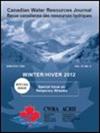加拿大草原坑坑湿地池塘溶解有机碳光敏特性随光照变化
IF 1.7
4区 环境科学与生态学
Q3 WATER RESOURCES
引用次数: 0
摘要
溶解有机碳(DOC)是全球碳循环的重要组成部分,为微生物提供碳源,并为紫外线辐射和水生生物之间提供保护屏障等生态服务。本研究考察了光降解对加拿大萨斯喀彻温省中部草原湿地池塘DOC光学特性的影响。从两个季节平均DOC浓度分别为71.1 mg L−1 (More-DOC Pond)和32.7 mg L−1 (Less-DOC Pond)的池塘中收集地表水,并通过1.2µm GF/Fs过滤到对紫外线透明的特氟龙瓶中。将样品分为暗光处理和光照处理,在3个不同深度(表面、0.25m和0.5 m)原位孵育,每2周采集一次,持续4个月。测量了300 ~ 800 nm的激发发射矩阵扫描和254 nm的吸光度。在254 nm处,多doc池和少doc池的吸光度分别下降34%和50%。在More-DOC池和Less-DOC池中,虽然DOC的总体浓度随时间变化没有显著差异,但C峰的荧光强度分别下降了39%和47%,M峰的荧光强度分别增加了19%和29%。其他荧光指标如荧光指数(35%和22%)和FRESH(29%和30%)也有所增加。总体而言,经过12周的孵育,我们取样池中的陆生DOC芳香性降低,脂肪性增加,分子量降低,吸收率和荧光强度下降。本研究结果将为进一步了解DOC的光学特征和来源提供依据,并为进一步研究DOC在草原湿地池塘中的作用奠定基础。本文章由计算机程序翻译,如有差异,请以英文原文为准。
Photosensitizing properties of dissolved organic carbon in Canadian prairie pothole wetland ponds change in response to sunlight
Abstract Dissolved organic carbon (DOC) is an important component of the global carbon cycle providing ecological services such as carbon sources for microorganisms and the provision of a protective barrier between ultraviolet radiation and aquatic organisms. Our study examined the impacts of photodegradation on the optical properties of DOC in prairie wetland ponds in central Saskatchewan, Canada. Surface water was collected from two ponds with seasonal average DOC concentrations of 71.1 mg L−1 (More-DOC Pond) and 32.7 mg L−1 (Less-DOC Pond) and filtered through 1.2 µm GF/Fs into Teflon bottles transparent to UV light. Samples divided into dark and light treatments were incubated in situ at three different depths (surface, 0.25m, and 0.5 m) and collected every 2 weeks for 4 months. Excitation emission matrix scans from 300 to 800 nm and absorbance at 254 nm were measured. Absorbance at 254 nm in the More-DOC Pond and Less-DOC Pond waters decreased by 34% and 50%, respectively. Two fluorescence components were identified corresponding to previous published peaks C and M. Although bulk DOC concentrations did not show significant differences over time, fluorescence intensity of peak C decreased by 39% and 47%, and of peak M increased by 19% and 29%, in the More-DOC Pond and Less-DOC Pond, respectively. Increases in other fluorescence indicators such as fluorescence index (35% and 22%) and FRESH (29% and 30%) were also observed. Overall, terrestrial DOC from our sampling ponds became less aromatic, more aliphatic, of lower molecular weight, and lost absorptivity and fluorescence intensity after 12 weeks of incubation. Results of this study will provide a better understanding of optical characterizations and sources of DOC, and act as a foundation to further study on the role of DOC in prairie wetland ponds.
求助全文
通过发布文献求助,成功后即可免费获取论文全文。
去求助
来源期刊

Canadian Water Resources Journal
WATER RESOURCES-
CiteScore
2.90
自引率
5.90%
发文量
17
审稿时长
>12 weeks
期刊介绍:
The Canadian Water Resources Journal accepts manuscripts in English or French and publishes abstracts in both official languages. Preference is given to manuscripts focusing on science and policy aspects of Canadian water management. Specifically, manuscripts should stimulate public awareness and understanding of Canada''s water resources, encourage recognition of the high priority of water as a resource, and provide new or increased knowledge on some aspect of Canada''s water.
The Canadian Water Resources Journal was first published in the fall of 1976 and it has grown in stature to be recognized as a quality and important publication in the water resources field.
 求助内容:
求助内容: 应助结果提醒方式:
应助结果提醒方式:


